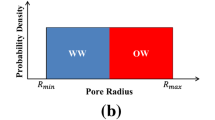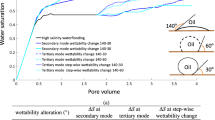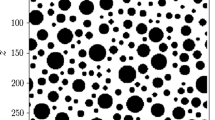Abstract
The potential of low-salinity (LS) water injection as an oil recovery technique has been the source of much recent debate within the petroleum industry. Evidence from both laboratory and field-level studies has indicated significant benefits compared to conventional high-salinity (HS) waterflooding, but many conflicting results have also been reported and, to date, the underlying mechanisms remain poorly understood. In this paper, we aim to address this uncertainty by developing a novel, steady-state pore network model in which LS brine displaces oil from a HS-bearing network. The model allows systematic investigation of the crude oil/brine/rock parameter space, with the goal of identifying features that may be critical to the production of incremental oil following LS brine injection. By coupling the displacement model to a salinity-tracking tracer algorithm, and assuming that a reduction of water salinity within the pore network leads to localised wettability alteration, substantial perturbations to standard pore filling sequences are predicted. The results clearly point to two principal effects of dynamic contact angle modification at the pore scale: a “pore sequence” effect, characterised by an alteration to the distribution of displaced pore sizes, and a “sweep efficiency” effect, demonstrated by a change in the overall fraction of pores invaded. Our study indicates that any LS effect will depend on the relative (scenario-dependent) influence of each mechanism, where factors such as the initial wettability state of the system and the pore size distribution of the underlying network are found to play crucial roles. In addition, we highlight the important role played by end-point capillary pressure in determining LS efficacy.











Similar content being viewed by others
References
Agbalaka, C.C., Dandekar, A.Y., Patil, S.L., Khataniar, S., Hemsath, J.R.: Coreflooding studies to evaluate the impact of salinity and wettability on oil recovery efficiency. Transp. Porous Med. 76, 77–94 (2009)
Ashraf, A., Hadia, N.J., Torsæter, O., Tweheyo, M.T.: Laboratory investigation of low salinity waterflooding as secondary recovery process: effect of wettability. In: Paper SPE 129012 Presented at the SPE Oil and Gas India Conference and Exhibition, Mumbai, 20 – 22 Jan (2010)
Austad, T., RezaeiDoust, A., Puntervold, T.: Chemical mechanism of low salinity water flooding in sandstone reservoirs. In: Paper SPE 129767 Presented at the SPE Improved Oil Recovery Symposium, Tulsa, 24 –28 Apr (2010)
Bernard, G.G.: Effect of floodwater salinity on recovery of oil from cores containing clays. In: Paper SPE 1725 Presented at the \(38^{{\rm th}}\) SPE California Regional Meeting, Los Angeles, 26–27 Oct (1967)
Blunt, M.J.: Effects of heterogeneity and wetting on relative permeability using pore level modelling. SPE J. 2, 70–87 (1997)
Blunt, M.J.: Flow in porous media—pore-network models and multiphase flow. Curr. Opin. Colloid Interface 6, 197–207 (2001)
Buckley, J.S., Liu, Y., Xie, X., Morrow, N.R.: Asphaltenes and crude oil wetting—the effect of oil composition. SPE J. 2, 107–119 (1997)
Dixit, A.B., McDougall, S.R., Sorbie, K.S., Buckley, J.S.: Pore-scale modelling of wettability effects and their influence on oil recovery. SPE Reserv. Eval. Eng. 2, 25–36 (1999)
Fjelde, I., Asen, S.M., Omekeh, A.: Low salinity water flooding experiments and interpretation by simulations. In: Paper SPE 154142 Presented at the \(18^{{\rm th}}\) SPE Improved Oil Recovery Symposium, Tulsa, 14–18 Apr (2012)
Jadhunandan, P., Morrow, N.R.: Effect of wettability on waterflood recovery for crude-oil/brine/rock systems. SPE Reserv. Eng. 10, 40–46 (1995)
Lager, A., Webb, K.J., Black, C.J.J., Singleton, M., Sorbie, K.S.: Low salinity oil recovery—an experimental investigation. In: Paper Presented at the International Symposium of the Society of Core Analysts, Trondheim, 12–16 Sept (2006)
Ligthelm, D.J., Gronsveld, J., Hofman, J.P., Brussee, N.J., Marcelis, F., van der Linde, H.A.: Novel waterflooding strategy by manipulation of injection brine composition. In: Paper SPE 119835 Presented at the EUROPEC/EAGE Annual Conference and Exhibition, Amsterdam, 8–11 June (2009)
Mahani, H., Berg, S., Ilic, D., Bartels, W.-B., Joekar-Niasar, V.: Kinetics of low-salinity-flooding effect. SPE J. 20, 8–20 (2015)
Mahmud, W.M., Arns, J.Y., Sheppard, A., Knackstedt, M.A., Pinczewski, W.V.: Effect of network topology on two-phase imbibition relative permeability. Transp. Porous Med. 66, 481–493 (2007)
Martin, J.C.: The effects of clay on the displacement of heavy oil by water. In: Paper SPE 1411-G Presented at the \(3^{{\rm rd}}\) SPE Venezuelan Annual Meeting, Caracas, 14–16 Oct (1959)
McDougall, S.R., Sorbie, K.S.: The application of network modelling techniques to multiphase flow in porous media. Pet. Geosci. 3, 161–169 (1997)
McGuire, P.L., Chatham, J.R., Paskvan, F.K., Sommer, D.M., Carini, F.H.: Low salinity oil recovery: an exciting new EOR opportunity for Alaska’s North Slope. In: Paper SPE 93903 Presented at the SPE Western Regional Meeting, Irvine, 30 Mar–1 Apr (2005)
Morrow, N.R., Tang, G.-Q., Valat, M., Xie, X.: Prospects of improved oil recovery related to wettability and brine composition. J. Pet. Sci. Eng. 20, 267–276 (1998)
Morrow, N., Buckley, J.: Improved oil recovery by low-salinity waterflooding. J. Pet. Technol. 63, 106–112 (2011)
Patil, S., Dandekar, A.Y., Patil, S.L., Khataniar, S.: Low salinity brine injection for EOR on Alaska North Slope (ANS). In: Paper IPTC 12004 Presented at the International Petroleum Technology Conference, Kuala Lumpur, 3–5 Dec (2008)
Sandengen, K., Tweheyo, M.T., Raphaug, M., Kjølhamar, A., Crescente, C., Kippe, V.: Experimental evidence of low salinity water flooding yielding a more oil–wet behaviour. In: Paper SCA2011-16 Presented at the International Symposium of the Society of Core Analysts, Austin, 18–21 Sept (2011)
Shaker Shiran, B., Skauge, A.: Enhanced oil recovery (EOR) by combined low salinity water/polymer flooding. Energy Fuels 27, 1223–1235 (2013)
Shehata, A.M., Nasr-El-Din, H.A.: Role of sandstone mineral compositions and rock quality on the performance of low-salinity waterflooding. In: Paper IPTC 18176 Presented at the International Petroleum Technology Conference, Kuala Lumpur, 10–12 Dec (2014)
Skauge, A.: Low salinity flooding—a critical review. In: Paper Presented at the \(17^{{\rm th}}\) European Symposium on Improved Oil Recovery, St. Petersburg, 16–18 Apr (2013)
Sorbie, K.S., Collins, I.R.: A proposed pore-scale mechanism for how low salinity waterflooding works. In: Paper SPE 129833 Presented at the SPE Improved Oil Recovery Symposium, Tulsa, 24–28 Apr (2010)
Tang, G.Q., Morrow, N.R.: Salinity, temperature, oil composition and oil recovery by waterflooding. SPE Reserv. Eng. 12, 269–276 (1997)
Tang, G.-Q., Morrow, N.R.: Influence of brine composition and fines migration on crude oil/brine/rock interactions and oil recovery. J. Pet. Sci. Eng. 24, 99–111 (1999a)
Tang, G.-Q., Morrow, N.R.: Oil recovery by waterflooding and imbibition—invading brine cation valency and salinity. In: Paper SCA-9911 Presented at the International Symposium of the Society of Core Analysts, Golden, 1–4 Aug (1999b)
Yildiz, H.O., Morrow, N.R.: Effect of brine composition on recovery of Moutray crude oil by waterflooding. J. Pet. Sci. Eng. 14, 159–168 (1996)
Yousef, A., Al-Saleh, S., Al-Kaabi, A., Al-Jawfi, M.: Laboratory investigation of novel oil recovery method for carbonate reservoirs. In: Paper SPE 137634 Presented at the Canadian Unconventional Resources and International Petroleum Conference, Calgary, 19–21 Oct (2010)
Acknowledgements
The authors would like to thank Total E&P for their financial support, technical assistance and permission to publish the paper.
Author information
Authors and Affiliations
Corresponding author
Electronic supplementary material
Below is the link to the electronic supplementary material.
Appendices
Appendix 1: Salinity Allocation to Newly Invaded Pores
The following procedure is used to assign salinity values to each pore newly invaded during the latest capillary pressure step:
-
1.
Identify newly displaced water-filled pores without bulk connectivity to the inlet (i.e. snapped-off pores). These pores are assumed to have accumulated pure HS water, and assignment of a nonzero tracer concentration is delayed until any such pore becomes part of a spanning water cluster.
-
2.
Assign a tracer concentration of one (i.e. salinity = 0) to all newly displaced inlet pores.
-
3.
Beginning from the inlet, track flow paths through the spanning water cluster(s) and assign tracer concentrations to all newly displaced, or newly connected, flowing pores according to the flow-weighted average concentration of upstream neighbours.
-
4.
Identify “dead-end” water clusters (i.e. pores branching from a backbone of flowing water pores but not yet flowing themselves), and non-spanning water clusters with bulk connectivity to the inlet. For each of these clusters, calculate the total cluster volume \(V_\mathrm{clus}\), the total mass of tracer newly added to the cluster \(M_\mathrm{new}\) (i.e. pores just displaced by LS injection), and the total mass of tracer in all previously displaced pores associated with that cluster \(M_\mathrm{old}\) (i.e. pores that were displaced by HS or LS at earlier times). Use these values to calculate a new average tracer concentration to assign to all pores within the cluster, \(C_\mathrm{clus} = (M_\mathrm{old} + M_\mathrm{new}) / V_\mathrm{clus}\).
Appendix 2: Salinity Updates in Flowing Water-Filled Pores
For each global saturation change following the onset of LS injection, a designated period of convective tracer transport is simulated to determine the salinity evolution within the flowing bulk water. Assuming a source concentration of one (i.e. salinity = 0) at inlet pores, and using the previously calculated elemental flow values q, tracer concentrations \(C_\mathrm{old}\) are updated as follows at each timestep \(\Delta t\):
-
(i)
Calculate the mass of tracer flowing out of each bond, \(M_\mathrm{out} = q \cdot \Delta t \cdot C_\mathrm{old}\);
-
(ii)
Sum the appropriate \(M_\mathrm{out}\) values to determine the total mass of tracer \(M_\mathrm{node}\) flowing into each node;
-
(iii)
Assuming perfect mixing in nodes, calculate the mass of tracer \(M_\mathrm{in}\) entering each outflowing bond according to \(M_\mathrm{in} = q / q_\mathrm{node} \cdot M_\mathrm{node}\), where \(q_\mathrm{node}\) represents the total flow into the node from all upstream bonds;
-
(iv)
Calculate the new tracer concentration \(C_\mathrm{new}\) in each bond according to \(C_\mathrm{new} = C_\mathrm{old} + {(}M_\mathrm{in} - M_\mathrm{out}{)} / V\), where V is the volume of the bond.
During the above procedure, the mass of tracer leaving any bond in a single timestep cannot be in excess of that available. Mass conservation therefore stipulates the condition \(\Delta t = \mathrm{min} (V/q)\), where the minimum is taken over all flowing bonds.
Rights and permissions
About this article
Cite this article
Watson, M.G., Bondino, I., Hamon, G. et al. A Pore-Scale Investigation of Low-Salinity Waterflooding in Porous Media: Uniformly Wetted Systems. Transp Porous Med 118, 201–223 (2017). https://doi.org/10.1007/s11242-017-0854-8
Received:
Accepted:
Published:
Issue Date:
DOI: https://doi.org/10.1007/s11242-017-0854-8




